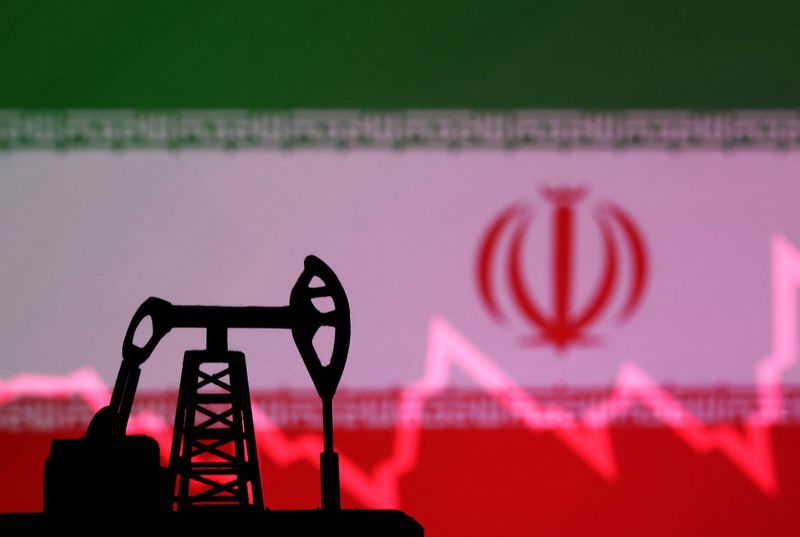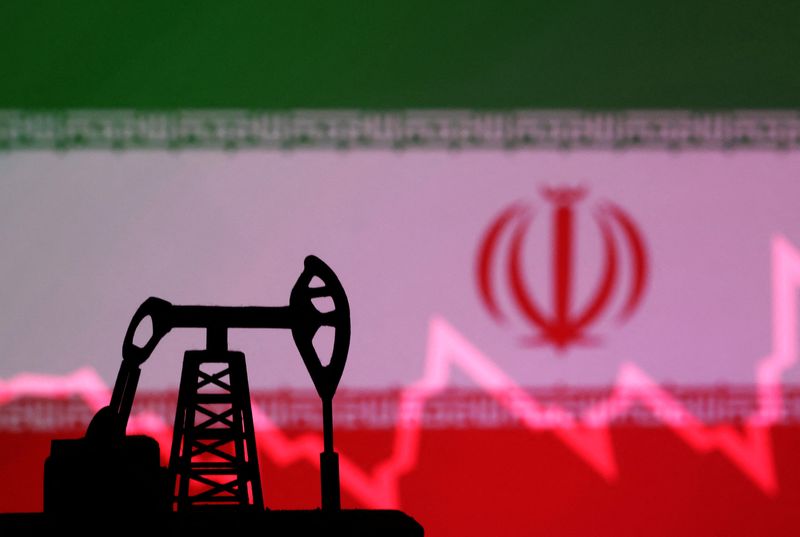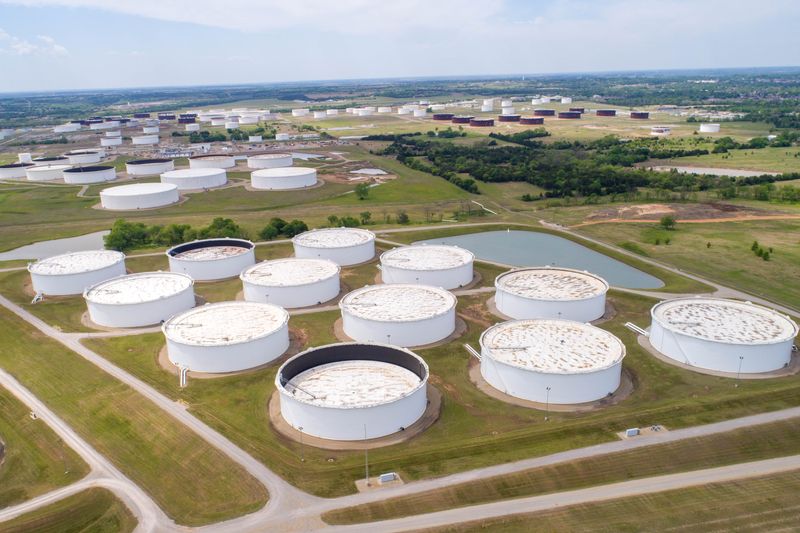Commodities
Oil seen opening up after Iran’s attack on Israel, but further gains may depend on response

By Alex Lawler, Robert Harvey and Ahmad Ghaddar
LONDON (Reuters) – Oil prices are expected to rise on Monday after Iran’s attack on Israel over the weekend, analysts said on Sunday, but further gains may depend on how Israel and the West choose to retaliate.
Iran launched explosive drones and missiles at Israel late on Saturday in retaliation for a suspected Israeli attack on its consulate in Syria on April 1, a first direct attack on Israeli territory that has stoked fears a wider regional conflict.
Concern of a response from Iran to the strike on its embassy compound in Damascus supported oil last week and helped send global benchmark on Friday to $92.18 a barrel, the highest since October.
It settled that day up 71 cents at $90.45, while U.S. West Texas Intermediate crude futures rose 64 cents to $85.66. Trading is closed on Sunday.
“It is only reasonable to expect stronger prices when trading resumes,” said Tamas Varga of oil broker PVM. “Having said that, there has been no impact on production so far and Iran has said that ‘the matter can be deemed concluded’.
“However fierce and painful the initial market reaction will be, the rally could prove to be short-lived unless supply from the region is materially disrupted.”
U.S. President Joe Biden said he would convene a meeting of leaders of the Group of Seven major economies on Sunday to coordinate a diplomatic response to the Iranian attack.
“Oil prices might spike at the opening as this is the first time Iran has struck Israel from its territory,” said UBS analyst Giovanni Staunovo.
“How long any bounce will last will… depend on the Israeli response,” Staunovo added. “Also today’s G7 virtual meeting needs to be monitored, with an eye on if they target or not Iranian crude exports.”
Iran has steeply raised oil exports – its main sources of revenue – under the Joe Biden administration. Exports were severely reduced under Biden’s predecessor Donald Trump, who will face Biden in a presidential election rematch in November.
The Biden administration has argued it is not encouraging Iran to raise exports and is enforcing sanctions.
Lower Iranian exports would lead to a further rise in oil prices and the cost of gasoline in the U.S., a politically sensitive subject ahead of the elections.
Another factor to watch will be any impact on shipping through the Strait of Hormuz, through which about a fifth of the volume of the world’s total oil consumption passes daily.

The commander of Iran’s Revolutionary Guard’s navy said on Tuesday Tehran could close the strait if deemed necessary, and earlier on Saturday, Iran’s state-run IRNA news agency reported a Guards helicopter had boarded and taken into Iranian waters a vessel, the Portuguese-flagged MSC Aries.
“Crude prices already included a risk premium, and the extent to which it will widen further almost exclusively depends on developments near Iran around the Strait of Hormuz,” said Ole Hansen at Saxo Bank.
Commodities
Gold prices sink below $2,300 as markets brace for hawkish Fed

Investing.com– Gold prices fell in Asian trade on Wednesday, extending steep overnight losses that saw the yellow metal slide past a key support level as markets braced for potentially hawkish signals from the Federal Reserve later in the day.
The yellow metal fell further from record highs hit in April as diminished safe haven demand, amid some de-escalation in global geopolitical tensions, left it vulnerable to headwinds from interest rates.
fell 0.1% to $2,285.19 an ounce, while expiring in June fell 0.3% to $2,295.25 an ounce by 23:50 ET (03:50 GMT). Spot prices fell below the closely-watched $2,300 an ounce level on Tuesday, leaving the yellow metal open to more losses before more cues on U.S. interest rates.
Fed meeting awaited, Powell to wax hawkish
Focus was now squarely on the conclusion of a two-day later on Wednesday, where the central bank is set to keep rates unchanged.
But Fed Chair Jerome Powell is widely expected to offer a hawkish outlook, especially after a string of hotter-than-expected inflation readings. A stronger-than-expected reading on the , for the first quarter, furthered this notion on Tuesday.
Strong inflation readings saw traders steadily price out expectations of early rate cuts by the Fed. The central bank is now only expected to begin cutting rates by September, if at all.
Higher-for-longer interest rates bode poorly for gold, given that they increase the opportunity cost of investing in the yellow metal. Dwindling expectations of rate cuts dragged gold prices down from record highs over the past two weeks.
remove ads
.
Other precious metals also fell on Wednesday, as the dollar shot up to near six-month highs. fell 0.2% to $943.95 an ounce, while fell 0.2% to $26.598 an ounce.
Copper prices fall from two-year highs after stellar April
Among industrial metals, copper prices fell from two-year highs amid pressure from a stronger dollar, while stellar gains through April also made for some profit-taking.
on the London Metal Exchange fell 0.8% to $9,910.0 a ton, while fell 0.3% to $4.5285 a pound.
Both contracts surged between 14% and 16% in April on expectations of tighter supplies, amid more sanction on Russia and production cuts by major Chinese refiners.
But fears of slowing economic growth- especially as interest rates remain higher for longer- may chip away at copper in the near-term.
Commodities
Oil falls for a third day on Middle East ceasefire hopes

By Alex Lawler and Deep Kaushik Vakil
LONDON (Reuters) -Oil fell more than 1% on Wednesday, losing ground for a third straight session on hopes of a ceasefire agreement in the Middle East and by rising crude inventories and production in top consumer the United States.
Expectations that a ceasefire agreement between Israel and Hamas could be in sight have grown following a renewed push led by Egypt, even as Israeli Prime Minister Benjamin Netanyahu has vowed to go ahead with a long-promised assault on Rafah.
futures for July were down $1.24, or 1.4%, to $85.09 a barrel by 1145 GMT, having hit $84.78, their lowest since March 15.
U.S. West Texas Intermediate crude futures for June were down $1.33, or 1.6%, to $80.60, after touching their lowest since March 21.
“The crude market is weighed down by continued hopes for a ceasefire,” said Ole Hansen of Saxo Bank.
“In addition, stubborn U.S. inflation has further reduced rate cut expectations.”
U.S. Federal Reserve officials are concluding their latest two-day policy meeting on Wednesday and are expected to hold interest rates steady. A rate cut would act as a boost to economic growth and fuel demand.
“Continued signs of inflation also raised concerns about demand for crude oil. This comes ahead of the U.S. driving season, where demand for gasoline rises strongly,” ANZ analysts said in a report on Wednesday.
Further weighing on prices were separate reports that inventories rose and production increased.
remove ads
.
U.S. crude inventories rose 4.906 million barrels in the week ended April 26, according to market sources citing American Petroleum Institute figures, which defied expectations for a decline of 1.1 million barrels.
Traders will be waiting to see if official data from the Energy Information Administration (EIA) at 1430 GMT confirms the trend.
On Tuesday, the EIA said U.S. production rose to 13.15 million barrels per day (bpd) in February from 12.58 million bpd in January, its biggest monthly increase in about 3-1/2 years.
Commodities
Oil prices sink on surprise US inventory build; Middle East peace talks eyed

Investing.com– Oil prices fell sharply Wednesday, extending recent losses as an unexpected build in U.S. stockpiles and strong crude production sparked doubts over tight supply conditions ahead of the Fed meeting.
At 08:25 ET (12:25 GMT), fell 1.4% to $85.15 a barrel, while fell 1.6% to $80.61 a barrel, dropping to their lowest levels since mid-March.
U.S. inventory build, strong output weighs
Data from the American Petroleum Institute, released on Tuesday, indicated that U.S. grew by 4.9 million barrels in the week to April 26, a far greater build than the increase of 1.5 million barrels expected.
While gasoline and distillate stockpiles shrank, if this rise in overall inventories id confirmed by , due later in the session, it would suggest that oil supplies were not as tight as initially expected in the world’s biggest fuel consumer.
This notion was reinforced by separate data showing U.S. domestic crude output rose to 13.15 million barrels per day in February from 12.58 million barrels in January, its biggest jump since October. The rise also saw U.S. production come back in sight of record highs.
This spurred doubts over just how tight global crude markets would be in the coming months, given that U.S. output remains robust and the country’s oil markets remain well supplied.
Fed fears in play, dollar strength weighs
Markets were also on edge ahead of the conclusion of a two-day policy meeting of the Federal Reserve later in the day.
remove ads
.
While the central bank is widely expected to , Fed Chair Jerome Powell is likely to strike a hawkish note following a series of strong inflation readings.
Expectations of higher-for-longer U.S. interest rates saw the dollar rise sharply this week, which also weighed on oil prices, with prolonged exposure to elevated interest rates likely to weigh on economic activity by the world’s largest consumer.
Middle East peace talks
A potential ceasefire between Israel and Hamas could also further downplay expectations of tighter markets, as it would lower the risks of supply disruptions in the key oil-rich Middle East.
Expectations that a ceasefire agreement between Israel and Hamas could be in sight have grown following a renewed push led by Egypt.
“The geopolitical risk premium continues to fade as tensions between Israel and Iran have eased. There are also some hopes for a potential ceasefire between Israel and Hamas,” said analysts at ING, in a note.
(Ambar Warrick contributed to this article.)

 Forex2 years ago
Forex2 years agoForex Today: the dollar is gaining strength amid gloomy sentiment at the start of the Fed’s week

 Forex2 years ago
Forex2 years agoHow is the Australian dollar doing today?

 Forex1 year ago
Forex1 year agoUnbiased review of Pocket Option broker

 Forex2 years ago
Forex2 years agoDollar to pound sterling exchange rate today: Pound plummeted to its lowest since 1985

 Cryptocurrency2 years ago
Cryptocurrency2 years agoWhat happened in the crypto market – current events today

 World2 years ago
World2 years agoWhy are modern video games an art form?

 Stock Markets2 years ago
Stock Markets2 years agoMorgan Stanley: bear market rally to continue

 Economy2 years ago
Economy2 years agoCrude oil tankers double in price due to EU anti-Russian sanctions

































